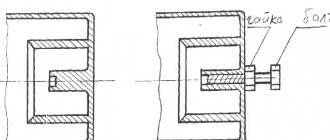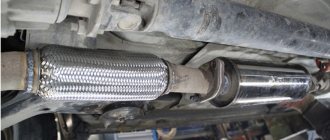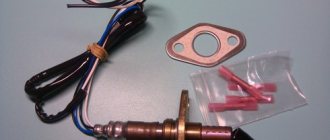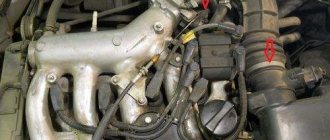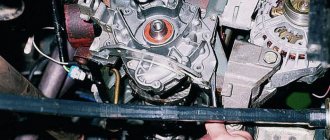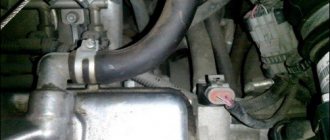Method number 2. Favorite method of 80% of services that don’t like to think
Consists of 2 stages:
a) Mechanical removal of the catalyst (to facilitate the passage of gases in the exhaust system) followed by installation of a flame arrester.
b) Installation of a mechanical blende, supposedly to prevent an error in the operation of the catalyst.
But let's figure out how mechanical snags work and why you can't install them.
To understand, let’s consider the design of installing a lambda probe normally and through a mechanical blende.
During the normal installation of the lambda probe, the exhaust gases are HEATED, CLEANED, VENTILATED and BURNED the sensor (operating temperature of the sensor is 350-400 degrees).
But as soon as you install it in a mechanical blende (take it away from the main flow), it clearly does not heat up (ALREADY LYING), is not ventilated, is not burned out, and if it somehow started working at the beginning, then the question arises how long it will take for it to stop working.
OUR CENTERS ON THE CITY MAP
1 Upper fields st., 2 +7
More details
2 MO, Raiki village, st. Central, 30 +7
More details
3 Dobrolyubova passage, 3 +7
More details
4 Ostashkovskoe highway, 14 +7
More details
5 Starokaluga Highway, 65 +7
More details
6 Kantemirovskaya St., 53 +7
More details
Do you want to inexpensively replace the catalyst with a VAZ 2112 flame arrester? “MSK Muffler” is an urgent replacement of catalytic converters for Lada 2112 with a 1-year warranty.
What is a catalytic converter
The exhaust system catalyst is the most expensive part of the muffler, the main function of which is to clean the exhaust gases from harmful impurities. The average service life of these components is approximately 120-150 thousand kilometers. The design of the catalyst consists of ceramic or metal “honeycombs” that act as a reusable filter.
Signs of breakdown of the VAZ 2112 catalyst
- difficulty starting the engine, and in more serious cases, the inability to start the engine;
- noticeable loss of power from the power plant;
- increased fuel consumption;
- Check Engine Light Signal
The main reason for premature failure of the catalytic converter is the low quality of the fuel used. The proposed price of a catalyst for imported cars starts from 30 thousand rubles.
Therefore, experts often suggest replacing the catalyst with a cheaper flame arrester. For diagnostics, the catalyst must be dismantled - there is no other way to accurately determine the integrity of this part. Methods such as checking the level of emissions of harmful substances and measuring the pressure at the outlet do not always allow accurate conclusions to be drawn.
Installing a flame arrester - advantages and disadvantages
A flame arrester is an analogue of a resonator, the main task of which is to reduce the noise level and temperature of the exhaust gases. The advantages of flame arresters can be listed as follows:
- relatively low cost;
- lack of response to low-quality fuel;
- a slight increase in engine power compared to a running catalyst;
Installing a flame arrester is characterized by the following disadvantages:
- lack of exhaust gas cleaning function;
- increased load on subsequent parts of the exhaust system
In order for this operation to be successful, we recommend that you purchase branded flame arresters, which are characterized by high operating efficiency and a long service life.
Our specialists will definitely advise you on the optimal models, and if necessary, the required part will be quickly delivered to the repair station. To find out how much it costs to replace a catalyst with a flame arrester, call our car service center at the phone number listed on this website.
Payment Methods
We accept:
- - Cash.
- — Credit cards (there is a terminal).
- — Cashless payments for organizations.
Method number 3. The mechanical component is no different from method 2.
But the implementation of normalization of engine operation is more complicated here: using special equipment, the engine control program is read and the EURO-2 program is loaded.
This is where the main questions arise: where was this program born, who created it, will it harm the operation of the engine, will problems appear after some time.
And how to solve them then?
“We flashed such cars” is not an argument.
Here the technology is as follows:
The program is read, uploaded to the Internet, another program is received and loaded into the machine.
“You see the check is not lit” - that means EURO-2. Why EURO-2, who said EURO-2, who created this program - there are only questions.
Most often, mistakes are made about catalysts, lambda probes and that’s it.
Popular myths
Varieties
Some people deliberately get rid of the catalyst, others deliberately ignore the clogged unit. All this caused the spread of myths.
- By removing it, the engine gains power. A misconception that arose for unknown reasons.
- The engine cannot “breathe” normally due to the catalyst. Absurd. It functions quite well if the cat itself is in working order.
- A clogged element ensures a more environmentally friendly ride. Another myth, the origin of which can only be guessed at. Rather, on the contrary, a clogged device harms nature and your car even more.
Therefore, monitor the condition of the catalyst on the VAZ 2114, check its functional condition, and if necessary, replace it with a new one or replace it with a flame arrester. Both options have shown their effectiveness.
1. Remove the Euro Catalyst (under the bottom in the muffler pipes) 2. Install the Zero Resistance Catalyst (spider) If Euro 2, then brain firmware is optional. If Euro 3, then it is necessary. Now the car breathes deeply, and can squeeze out higher revs, receives more oxygen, which makes the engine happy, and by chance the poor quality of gasoline does not bring it a choking death. There are no nuances, all advantages, with the exception of the unscrupulous attitude towards our ecology, which has already been killed in the trash.
-Briefly about the important things:
“Irregularities in engine operation, for example, misfires, operation on low-quality fuel, faulty lambda probes, etc., can lead to an increase in the temperature of the catalyst and its destruction (the “honeycomb” of the catalyst can melt and clog). If the catalyst is hit (the car hits an obstacle), its ceramic filling may collapse and clog the exhaust tract. Catalysts cannot be repaired. The new catalyst is quite expensive and, which is a shame, won’t work on Russian fuel for long.”
Method number 4. Now the method that we chose, we implemented it.
In the mechanical component, after removing the catalyst from the housing, we make a system inside the catalyst housing that dampens the sound so that it is not loud after removal. At the same time, we do not change the factory geometry of the pipes, and there are no external changes. From an electronics point of view, we connect an electronic device (emulator) developed by us to the standard lambda probe sensor, which is in its original place, which changes the sensor signal so that the control unit concludes that the catalyst is installed and functioning correctly. At the same time, by definition, we cannot harm anything.
Firmware for EURO2 and snag – what does this mean?
As I wrote above, the second oxygen sensor (lower lambda) controls harmful emissions. Their number is now strictly regulated by European standards, which are called “EURO”; I will not talk about EURO “0-1” now; we are interested in the second generation.
So, what is EURO2 ? It was introduced a long time ago, namely in 1996. AT that time, the cars received an innovative system, namely a catalyst. As we all know, over time it can become clogged, and the fuel then was not the same as now, it had a lot of sulfur, which contributed to the honeycombs clogging much faster, and as you and I know, the car began to choke itself. Then the engineers installed an oxygen sensor, there was only one, and it was needed to capture CO2 in the chamber in front of the catalytic converter.
If the CO2 level increased, this indirectly indicated that the catalyst was clogged (that is, a backpressure effect was manifested); the sensor sent this information to the ECU and the ignition was adjusted, namely, a decrease in the supply of the fuel mixture. Thus, the power dropped significantly, the car did not drive and the owner “willy-nilly” had to go to a service station and change this spare part.
BUT, as you and I know, the price tag is, to put it mildly, HIGH, so many owners simply removed these honeycombs and the POWER RESTORED!
But how? YES, everything is simple, the CO2 level in the chamber in front of the neutralizer dropped significantly, the oxygen sensor recorded this (that everything is in order) and the car drove cheerfully and without constraint. This suited everyone, BUT NOT ECOLOGISTS! Therefore, they introduced the EURO3 standard (now the EURO5 standard already exists). What has changed is that a second oxygen sensor (lower lambda) just appeared behind the catalyst. The principle of operation here is this : the first lambda (before the filter) records the level of harmful substances, the second (after it) should record a much lower level, because the harmful substances have decomposed.
If you remove the catalyst cells , then both sensors will record the same values (“the second one” supplies information to the ECU), thus, CHECK ENGINE will light up, the power will drop, and the car will not drive. Now this doesn't solve the problem.
What is done with firmware for EURO2? The firmware in the ECU is changed, instead of EURO3.4 standards, EURO2 standards are installed. The essence of all these actions is banal - we simply turn off the second lower lambda (only the upper one remains), the car begins to drive as expected, without underestimating the power.
But such interventions in the firmware are not entirely good. The whole point is that they don’t produce them themselves, okay, the second “lambda” is simply turned off, that is, they simply adjust the readings. Or maybe this programmer will want to put some incomprehensible algorithms into the ECU, the engine will definitely not benefit from this. You need to be very careful here.
Therefore, we found a second solution, and I think it is more correct - installing a blende. What is a snag - essentially it is a “spacer” in front of the second oxygen sensor, it seems to move it a greater distance from the exhaust gases, it detects more oxygen and starts working normally.
Now there are several options for deception:
- Empty . It's just a tube with a very thin hole at the end (the part that screws into the muffler), and an oxygen sensor is screwed into the other side. A limited amount of harmful substances from the exhaust passes through it, there are no excesses and therefore CHECK does not burn.
- With a mini-catalyst inside . That is, right in the “spacer” there are, as it were, mini honeycombs, which also clean the exhaust precisely to record normal values.
- Angular . These are both of the types described above, only they are made at an angle of 90 degrees; they are needed for difficult places.
The advantages of the decoy are that you don’t need to go into the ECU and change the standard firmware, as well as the price (knocked out the cells, screwed on the decoy and that’s it, you can spend 3,000 - 5,000 rubles).


